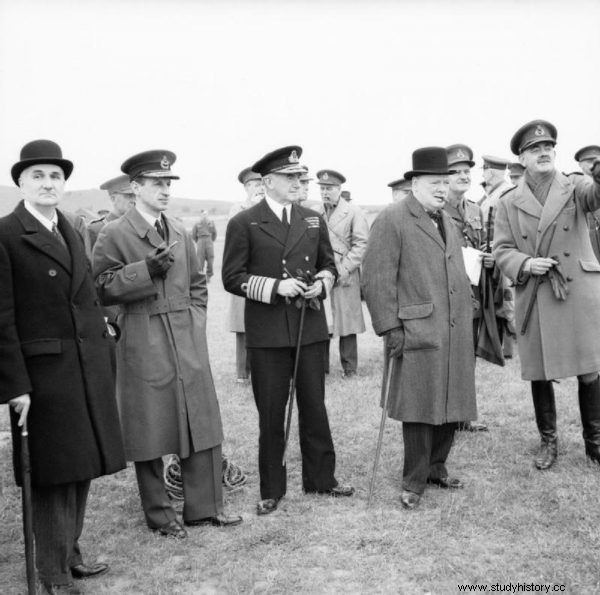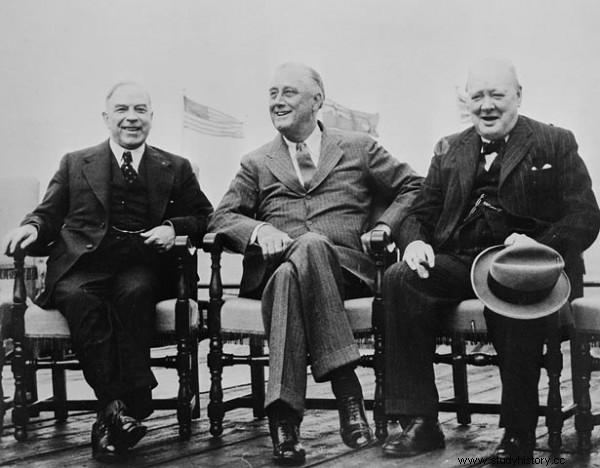Great Britain took an active part in the armed race that ended with the creation of the atomic bomb. The dispute continues to this day - was the participation of scientists from the Isles crucial to the cause? Has Churchill missed an opportunity to become nuclear power faster?
When it became clear that the creation of an atomic bomb was only a matter of time, the countries participating in World War II immediately set to work. In the summer of 1939, it was proved that weapons using the uranium nuclear chain reaction could be relatively light and easy to use - but much more disturbingly, the calculations were made by scientists from Berlin:Rudolf Peierls and Otto Frisch. Are the Germans already conducting their research?
The letter informing about the possibility of building a bomb was brought to the MAUD Committee (the name probably comes from a strange entry in the telegraph from Niels Bohr, in which he mentions his cleaner named Maud Ray) under the direction of Henry Tizard. In 1942, its scientists stated in a report that:
Even if the war ended before the bombs were manufactured, these efforts would not be in vain, because no nation would risk being left without a weapon that is equally crucial.
Difficult conversations
While scientists were working on preliminary designs involving the possibility of colliding two pieces of uranium in the barrels of parachute-lowered gun barrels facing each other (this is what the first plans for nuclear weapons actually looked like), politicians had completely different problems on their heads. Churchill's adviser Frederick Lindemann urged the prime minister to take the nuclear program seriously without delay. "We have to move forward." - he said - "It would be unforgivable if we allowed the Germans to carry out this program before us so that they could defeat us" . At the same time, he argued that the Americans could prove very helpful, but that they were not 100% reliable. Already back then, hostile intelligence was feared at every step, and both America and Britain had recruited spies.

Frederick Lindemann and Winston Churchil, 1941
Therefore, Lindemann was of the opinion that the work should be carried out domestically, to which Churchill agreed when he promoted Sir John Anderson as a candidate for minister for nuclear weapons. An opponent of such a solution was Henry Tizard himself, who considered it absurd for tactical reasons - bombs would be constructed in a country at war and a constant threat of an air raid. At the time, the people of Great Britain were constantly afraid of an invasion .. .
Regardless of this, however, it was decided to start the program in line with Churchill's recommendations. Soon the MAUD Committee handed over the first report to the American side.
Misunderstanding
Work proceeded very slowly. The report went to Vannevar Bush, chairman of the US National Research Committee for military nuclear research, and went straight to President Roosevelt. In the fall of 1941, the head of the USA turned to the Prime Minister of Great Britain with a proposal for open cooperation and exchange of experiences ... And it ended there, because the Americans had to wait two months for a response from Churchill!
According to many historians, the British politician missed a great opportunity delaying the answer . If it fell faster, Great Britain would have a better chance of negotiating favorable terms of the treaty. Meanwhile, this did not happen, and scientists in the US began to make great strides. The British, who at first appeared to be pioneers in nuclear projects, have been relegated to an emergency lane.
In June 1942, there was a meeting between Roosevelt and Churchill in Washington, during which politicians agreed to "immediately gather all information together, act together on equal terms and share all results fairly among themselves." However, the reality turned out to be quite different:the constant tightening of security measures resulted in scientists in the Islands being removed from their work. In 1943, Vannevar Bush suggested breaking cooperation with Great Britain altogether, but Roosevelt decided to continue it.
In this situation, Churchill reconsidered starting a nuclear project in his own backyard, but it proved to be practically impossible economically .

Mackenzie King, Franklin D. Roosevelt, and Winston Churchill. Quebec 1943.
Later that year, he met Roosevelt again, but again failed to move things forward. In August and September 1943, the politicians met at the Roosevelt estate in Quebec until it was finally agreed that British and American achievements in the work on the bomb should be combined. The condition was that, as America bore most of the project costs, Britain would use any commercial and industrial opportunities arising from a joint project under the terms of the US President and UK Prime Minister. This agreement, however, was informal, and both nations held a grudge against their representatives. Worse, the agreement was broken shortly after the war.
Unexplained issues
How much British scientists contributed to the atomic bomb has been argued for a long time and without conclusions. While Churchill claimed that his countrymen played first fiddle in laboratories, General Groves (director of the Manhattan Project) said they were helpful but not decisive . McGeorge Bundy, an adviser to President Kennedy, believed that without the British there would be no bomb in 1945.
After the war, a new nuclear program was launched in the UK under the leadership of William G. Penney. Minister Attlee allowed the resumption of work on the construction or purchase of nuclear weapons, which was officially revealed in 1948. In the same year, the construction of the Atomic Energy Research Centers began. The first reactor was installed in Harwell and was named BEPO (Britain Experimental Pile Zero).
In 1953, the first British nuclear weapon was created - the Blue Danube (also known as Smallboy and Special Bomb). At that time (before the first hydrogen bomb was detonated), plans were made to expand the arsenal to 800 similar warheads, with 200 weapons expected to be assembled by 1957. It soon turned out, however, that even more powerful variants of the ultimate weapon existed, so, like the rest of the powers, Great Britain began to develop new models…
Bibliography:
- Braithwaite, R., Armageddon and paranoia. Znak Horyzont, Krakow, 2019.
- Kubowski, J., History of the atomic bomb. United States, German Reich, Soviet Union. Poligraf Publishing House, Wrocław, 2014.
- Texts of the Frisch-Peierls memorandum and the MAUD Report in:P. Henessy, Cabinets and the Bomb, Oxford, 2007.
